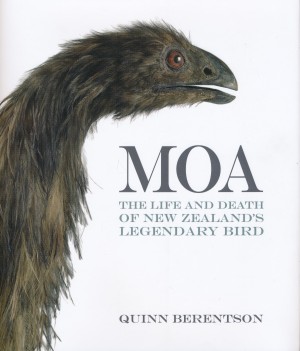Moa The Life and Death of New Zealand's Legendary Bird
Contents
Moa The Life and Death of New Zealand's Legendary Bird
Berentson, Quinn, 2012, Craig Potton Publishing, 200pp.ISBN 9781877517846
Blurb:
The moa were the most unusual and unique family of birds that ever lived, a clan of feathered monsters that developed in isolation for many, many millions of years. They became extinct reasonably quickly after the arrival of the Maori, and were a distant memory by the time European explorers arrived. So the discovery and identification of their bones in the 1840s was a worldwide sensation, claimed by many to be the zoological find of the century. This book begins by recounting the story of discovery, which was characterised by an unbelievable amount of controversy and intrigue. Since then there has been an unbroken chain of new discoveries, culminating with intriguing revelations in recent years about the moa's biology, that have come to light through DNA testing and radio-dating. This is a fascinating and important book that richly recounts the life and death of our strangest bird. Packed with a fantastic range of illustrations, Moa fills an important gap in our natural history literature, a popular but serious book on this national icon.
Mini Review
This is a POP page.
|
Berentson and the publisher Potton have produced an attractive book. Its treasures are the illustrations he has garnered - many from historical sources. As a zoologist Berentson has covered well the history of the discovery and the modern understanding of the species and their distribution. Does it add much to other recent contributors such as Anderson, Wolfe and Worthy and Holdaway? On the history of discovery no - it has pretty much all been said before though this is a readable account - if somewhat discursive into descriptive sections on New Zealand at large. The history is well related to the 19th century development of biological science, On the zoology it now summarises the revolutionary outcomes of a great deal on DNA research into moa's relatives and local relationships. On the archaeology it is much more limited. The section here reads as detached from the evidence and has too much of a story of credible conjectures which have little firm support. He seems little aware of the 19th century revolution in the understanding of prehistoric man that sucked Haast in and Berentson gives him little credence as a result. On the supposed historical sightings of moa a little less credulity would have assisted.
References
Anderson A. 1989 Prodigious Birds: Moas and Moa-Hunting in New Zealand, Cambridge University Press.
Woolfe R. 2003 Moa: The Dramatic Story of the Discovery of a Giant Bird, Penguin.
Worthy T. H., Richard N. Holdaway 2002 The Lost World of the Moa, Indiana University Press.
